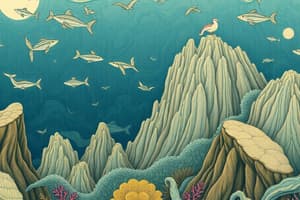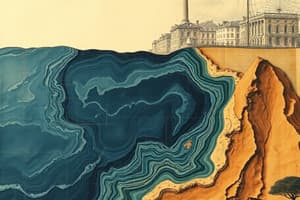Podcast
Questions and Answers
The highest part of the wave is called the ______.
The highest part of the wave is called the ______.
crest
The lowest part of the wave is known as the ______.
The lowest part of the wave is known as the ______.
trough
The distance from one crest to the next is referred to as the ______.
The distance from one crest to the next is referred to as the ______.
wavelength
Erosion is the movement of weathered particles, while ______ is the breakdown of rocks.
Erosion is the movement of weathered particles, while ______ is the breakdown of rocks.
A sandy beach forms on a shoreline with a gentler slope and calm waters, allowing ______ to settle and build up.
A sandy beach forms on a shoreline with a gentler slope and calm waters, allowing ______ to settle and build up.
Satellites can survey large areas of ocean in a relatively short ______.
Satellites can survey large areas of ocean in a relatively short ______.
When waves erode a cave into the rock, it is referred to as a ______.
When waves erode a cave into the rock, it is referred to as a ______.
Core sampling involves taking samples of the ocean floor directly for analysis of the layers of ______.
Core sampling involves taking samples of the ocean floor directly for analysis of the layers of ______.
The difference in level between high tide and low tide is known as the ______.
The difference in level between high tide and low tide is known as the ______.
When erosion causes a piece of rocky land to be cut off from the rest of the land, it is called a ______.
When erosion causes a piece of rocky land to be cut off from the rest of the land, it is called a ______.
Underwater photography includes new deep sea cameras that can take pictures 6000m beneath the ocean's ______.
Underwater photography includes new deep sea cameras that can take pictures 6000m beneath the ocean's ______.
Deep sea submersibles are small but extremely strong vehicles capable of traveling to great ______.
Deep sea submersibles are small but extremely strong vehicles capable of traveling to great ______.
Ocean currents can be affected by wind (surface currents) or temperature and ______ (deep water currents).
Ocean currents can be affected by wind (surface currents) or temperature and ______ (deep water currents).
The Gulf Stream carries warm water from the tropics past Newfoundland, making the Grand Banks one of the worlds richest resource ______.
The Gulf Stream carries warm water from the tropics past Newfoundland, making the Grand Banks one of the worlds richest resource ______.
Waves are large ripples in the ocean caused by ______.
Waves are large ripples in the ocean caused by ______.
A tsunami can be set in motion by earthquakes on the ocean floor, landslides, or volcanic ______ near the shoreline.
A tsunami can be set in motion by earthquakes on the ocean floor, landslides, or volcanic ______ near the shoreline.
The five major oceans from largest to smallest include the Pacific, Atlantic, Indian, Southern, and ______.
The five major oceans from largest to smallest include the Pacific, Atlantic, Indian, Southern, and ______.
The process of ______ involves the movement of rock material and has contributed to the formation of ocean basins.
The process of ______ involves the movement of rock material and has contributed to the formation of ocean basins.
The ______ is the submerged part of the continent closest to the shore.
The ______ is the submerged part of the continent closest to the shore.
The largest oceanic ridge is known as the ______ Ridge, located in the Atlantic Ocean.
The largest oceanic ridge is known as the ______ Ridge, located in the Atlantic Ocean.
Glaciers play a major role in ______, helping to develop continental drainage systems.
Glaciers play a major role in ______, helping to develop continental drainage systems.
The ______ trench is the deepest trench known, capable of submerging an object as tall as Mount Everest.
The ______ trench is the deepest trench known, capable of submerging an object as tall as Mount Everest.
Ocean ridges are caused by magma from the Earth's hot core that ______ up and hardens.
Ocean ridges are caused by magma from the Earth's hot core that ______ up and hardens.
Sonar is a method used to explore the ocean floor by sending out sound waves that ______ back to provide depth information.
Sonar is a method used to explore the ocean floor by sending out sound waves that ______ back to provide depth information.
Flashcards
Ocean Basin
Ocean Basin
A low spot on Earth's surface surrounded by high land, filled with water over millions of years.
Continental Shelf
Continental Shelf
The submerged edge of a continent, sloping gradually away from the shore.
Continental Slope
Continental Slope
A steeply sloping area at the edge of the continental shelf, leading to the deep sea floor.
Abyssal Plain
Abyssal Plain
Signup and view all the flashcards
Ocean Ridges
Ocean Ridges
Signup and view all the flashcards
Ocean Trenches
Ocean Trenches
Signup and view all the flashcards
Sonar
Sonar
Signup and view all the flashcards
Pangea
Pangea
Signup and view all the flashcards
Ocean current
Ocean current
Signup and view all the flashcards
Surface currents
Surface currents
Signup and view all the flashcards
Deep water currents
Deep water currents
Signup and view all the flashcards
Swell
Swell
Signup and view all the flashcards
Breaker
Breaker
Signup and view all the flashcards
Tsunami
Tsunami
Signup and view all the flashcards
Deep sea submersible
Deep sea submersible
Signup and view all the flashcards
Core sampling
Core sampling
Signup and view all the flashcards
Crest of a wave
Crest of a wave
Signup and view all the flashcards
Trough of a wave
Trough of a wave
Signup and view all the flashcards
Amplitude of a wave
Amplitude of a wave
Signup and view all the flashcards
Wavelength of a wave
Wavelength of a wave
Signup and view all the flashcards
Weathering
Weathering
Signup and view all the flashcards
Erosion
Erosion
Signup and view all the flashcards
Deposition
Deposition
Signup and view all the flashcards
Tidal Range
Tidal Range
Signup and view all the flashcards
Study Notes
Ocean Basins
- A low spot on Earth's surface, surrounded by high land, that fills with water over millions of years.
- Five major oceans (largest to smallest): Pacific, Atlantic, Indian, Southern, Arctic.
Formation of Oceans
- Volcanic Action: Water vapor released from volcanic materials cooled, condensed, and flowed into ocean basins.
- Plate Tectonics: Pangea, a supercontinent, broke apart, separating continents and forming the oceans we have today.
- Erosion: The breakdown and movement of rock material constantly shapes ocean basins.
- Glaciation: Glaciers erode land, contributing to drainage systems and shaping landscapes during ice ages.
Ocean Floor Features
- Continental Shelf: The submerged part of a continent close to the shore, gradually sloping away. The Grand Banks off Newfoundland is a notable example.
- Continental Slope: Steeply sloping area at the edge of the continental shelf, leading to the abyssal plain.
- Abyssal Plain: Flat areas on the deep ocean floor.
- Ocean Ridges: Long undersea mountain ranges formed by magma rising from Earth's core. The Mid-Atlantic Ridge is the largest.
- Ocean Trench: Deep depressions in the ocean floor formed when tectonic plates collide. The Mariana Trench is the deepest.
Exploring the Ocean Floor
- Sonar: Uses sound waves to map the ocean floor and determine depth.
- Satellites: Survey large areas of the ocean quickly, gathering data in all types of weather.
- Core Sampling: Taking samples of the ocean floor to study its layers and composition.
- Underwater Photography/Videography: Using cameras to capture pictures and videos of the deep ocean.
- Deep Sea Submersibles: Small, strong vehicles that explore the deepest parts of the ocean providing detailed information.
- Diving: Physically going into the water to explore, with limited depth due to pressure.
Ocean Currents
- Current: Large amounts of ocean water moving in a specific direction. Influenced by wind (surface currents) and temperature/density (deep water currents).
- Local Currents:
- Labrador Current: Cold water current.
- Gulf Stream: Warm water current affecting Newfoundland's climate due to interaction with Labrador current.
Ocean Waves
- Waves: Large ripples in the ocean caused by wind.
- Types:
- Swell: Smooth waves in calm weather.
- Breaker: Waves that collapse near the shore.
- Tsunami: Large waves caused by earthquakes, landslides, or volcanic eruptions.
Wave Interactions with Shorelines
- Wave Erosion: Rocks are worn down.
- Sediment Deposition: Material is carried and dropped.
- Tides: Affect shorelines by interacting with wave energy and currents.
- Shoreline Features: Rocky beaches, sandy beaches, headlands, and bays created and shaped by waves.
Ocean Tides
- Tides: Daily rise and fall of ocean water.
- Tidal Range: Difference in water level between high and low tides.
- Spring Tides: High tide/low tide range due to Sun, Earth, and Moon aligning.
- Neap Tides: Smaller tidal range due to Sun and Moon being at right angles.
Studying That Suits You
Use AI to generate personalized quizzes and flashcards to suit your learning preferences.




